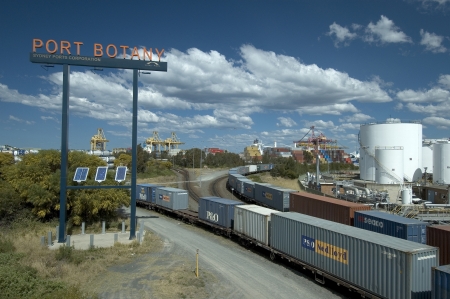
Photo courtesy of Sydney Ports Corporation.
Opinion – Greg Cameron
Selling a 99-year lease to Port Botany Container Terminal for $2 billion is bad economics.
The deal requires Australian taxpayers to pay $4 billion for upgrading Northern Sydney Freight Corridor, in addition to improvement work costing $1.1 billion now underway. Sydney’s Metropolitan Freight Network would need to be retained just to service Port Botany Container Terminal.
But allocating metropolitan rail capacity to freight comes at great cost. According to Deloitte Access Economics, ”if rail absorbed 30% of the forecast increase in [Sydney] urban travel then congestion, safety and carbon emission costs could be reduced by around $1 billion a year by 2025.”
Optimum financial, economic and social benefits would be realised when 100 per cent of Sydney’s metropolitan rail network was utilised for passenger services.
Operating Port Botany Container Terminal for the next 99 years means that the crippling effects on traffic caused by container-carrying trucks in the airport precinct, and on the M5, would only worsen, as truck numbers steadily increased over time.
There is an alternative to selling the lease to Port Botany Container Terminal. It is to lease the container terminal site at Newcastle for a state-of-the-art container terminal. The Port Botany Container Terminal would close after the Newcastle terminal opened. The Port Botany site would be leased for airport use to improve air freight and passenger services.
A freight rail line would be built between Newcastle and Badgery’s Creek by private enterprise. This would save taxpayers $4 billion by not upgrading Northern Sydney Freight Corridor and up to $1 billion a year when 100 per cent of the metropolitan rail network was used for passenger services. Containerised goods would reach their ultimate destinations in Sydney faster when containers were unloaded from ships at Newcastle, than when they were unloaded from ships at Port Botany.
Maximum advantages of road transport would be achieved by better planning short journeys and point-to-point distribution from warehouses in western Sydney and suburban distribution hubs.
An intermodal terminal could be built at Badgery’s Creek immediately. It would be located on a small part of the government-owned 1,700 hectare site already zoned for airport and industrial use. This terminal would be serviced by rail from Port Botany by extending the South West Rail Line, currently under construction, between Glenfield and Leppington – a mere 10 km from Badgery’s Creek. Freight capacity would be added to the line.
Communities affected by container truck activity would benefit immediately as rail became the dominant form of container transportation between the port and the intermodal terminal.
The $970 million bill to Australian taxpayers for building Moorebank Intermodal Terminal would be avoided if Badgery’s Creek Intermodal Terminal and dedicated freight rail line from Port Botany were to be completed around the same time as planned for the Moorebank project.
Last year, four heavyweight reports by the NSW government recommended identification and preservation of the Outer Western Sydney Orbital Road/Rail Corridor: NSW State Infrastructure Strategy, NSW Long-Term Transport Masterplan, Draft NSW Freight and Ports Strategy, and Joint Study on Aviation Capacity in the Sydney Region.
An earlier report, the 2007 Pearlman Review of the F3 to M7 Corridor Selection, found that “there are strategic reasons why an additional corridor to the north will be justifiable at least in some time in the future. These reasons arise from the vulnerability of the F3 to closure because of accident, bushfire and the single HawkesburyRiver crossing.”
Construction of the freight rail line between Newcastle, Badgery’s Creek and Glenfield could be completed before the freight capacity of the Metropolitan Freight Network reached its limit in 2028.
There would be no cost to taxpayers because the projects would be privately funded. This covers: Newcastle Container Terminal; Newcastle to Glenfield freight rail line; and Badgery’s Creek Intermodal Terminal. All costs would be covered by setting an appropriate, long term, charge for container transportation.
A container terminal at Newcastle would enable goods destined for northern NSW to be dispatched from Newcastle. Container terminals provide strong economic benefits when established in regional areas. Economic growth in northern NSW would also help stem population drift to Sydney.
For western Sydney, it would be possible to create long term economic development plans based on the certainty of rail freight and intermodal terminal services, at Badgery’s Creek.
Intending purchasers of the 99-year Port Botany Container Terminal lease would be well advised to find out whether the Australian Government had set aside $4 billion for upgrading the Northern Sydney Freight Corridor, before they signed up. If the Australian government has agreed to provide the funds, an outer western Sydney freight rail line would not be built because Sydney does not require two freight rail lines.
However, if the Australian government has not allocated the funds, and if the Coalition will not commit the funds should it win office in September, why do Labor and the Coalition decline to investigate the Newcastle alternative?





